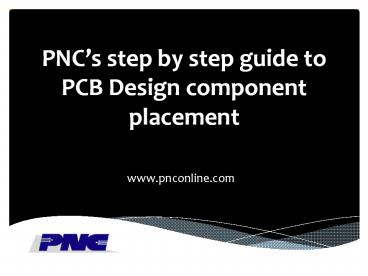PNC’s step by step guide to PCB Design - PowerPoint PPT Presentation
Title: PNC’s step by step guide to PCB Design
1
PNCs step by step guide to PCB Design component
placement
www.pnconline.com
2
A schematic is an abstraction, a representation
of an ideal circuit. A PCB Assembly, on the
other hand, is a complex mechanical assembly.
All the components in the circuit design must fit
within the physical boundary of the PCB. The
designer must locate and place hundreds of
components subject both to the mechanical
constraints of the product design and the
manufacturing process while not introducing
electrical noise into the circuit. It can seem
overwhelming to someone new to the PCB layout
process. Fortunately, there are some simple
guidelines used by the designers at PNC that will
help break the layout task into manageable
pieces.
3
Initial component placement considerations
Start by identifying the mechanical constraints
on the component location. The Printed Circuit
Board size and shape will be defined by the
overall product configuration. Typically, the
products mechanical design will define the
location of the connectors, the keep-out zones
and the locations of the heat sinks. The initial
mechanical layout of the PCB is often an
iterative process defined during design and early
prototyping.
The next step is to divide the PCB into
functional modules to simplify routing and
grounding. This will help minimize noise between
power components, high speed digital components
and analog components. Switching power supplies
are particularly noisy, so the power supplies and
their associated components should be grouped
together as far as possible from noise sensitive
sections of the circuit. While defining the
location of the modules, be aware that high power
components will need heat sinks, which may limit
placement options.
4
Locating active components
Once the edge components are placed and
functional areas of the Printed Circuit Board are
defined, the next step is to locate the BGAs,
quad packs and other large high pin count
components. The room needed to fan out their
pin counts is going to drive the locations of all
the components around them.
5
Locating Passive Components
As a follow on to locating the active components,
the bypass or decoupling capacitors on the power
pins should be located as close to the IC as
practical to minimize the parasitic inductance.
If more than one capacitor is being used PNC
recommends that the lowest value capacitor should
place closest to the power pin. If components
will be located on both sides of the PC Board,
the bypass capacitors are often located on the
opposite side, directly under the power pin. If
possible, each power pin should have its own
bypass capacitor.
6
Layout of double-sided boards
Double sided PCBs, PCBs with components on both
sides, are expensive to produce, but may be
necessary when real estate on the PCB design is
tight, and when the overall product form factor
is more important than PCB cost. A double-sided
PCB is more expensive because it will need to
pass though the pick and place machine and reflow
oven twice.
7
Schedule a Design Review with your PCBA
manufacturer
These are some general guidelines to aid in
component placement used by the PCB designers at
PNC. However, they are just guidelines. The
best way to ensure that the printed circuit board
assembly can be manufactured reliably is to have
the layout reviewed by the people who will
manufacture it.
PNCs designers can review your design to help
reduce production cost and improve yield and
reliability. Contact PNC today to schedule a
review.
8
Contact Details
Address PNC INC, 115 East Centre St. Nutley,
NJ, 07110
Phone (973) 284-1600
Email sales_at_pnconline.com
Website www.pnconline.com

